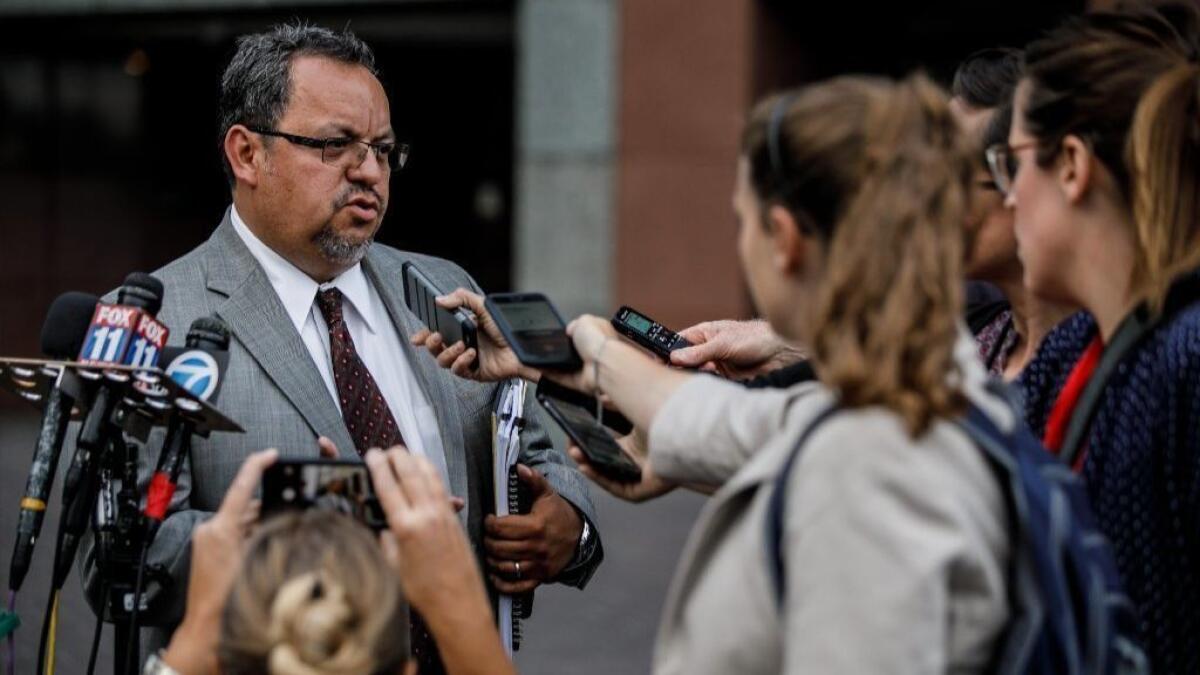Trained in California, a white supremacist fight club is accused of bringing violence to Charlottesville
- Share via
When Benjamin Drake Daley arrived in Charlottesville, Va. from Redondo Beach, he stopped by Walmart to pick up supplies: white athletic tape, black spray paint and a folding tactical knife.
Later that day in August 2017, prosecutors say, Daley taped his fists as if he were a boxer or mixed martial arts fighter and showed up at the University of Virginia, where he marched through campus with hundreds of torch-toting white supremacists shouting racist and anti-Semitic slogans.
For the record:
6:55 a.m. Oct. 3, 2018An earlier version of this article indicated that Brian Levin worked at UC San Bernardino. Levin is the director of the Center for the Study of Hate and Extremism at Cal State San Bernardino.
Daley and several others had traveled from California on behalf of the so-called Rise Above Movement, a relatively small militant white power group based in Southern California that casts itself as an alt-right fight club. Its members meet regularly in public parks to practice boxing and other street-fighting techniques to unleash on political foes.
For more than a year, authorities say, the group has caused trouble across California, at political rallies in places such as Berkeley and Huntington Beach. They are an odd collection of true believers; one worked as an aerospace engineer for Northrop Grumman, another at a hot dog restaurant. It appears far-right politics and hate brought them together, and after the chaos in Charlottesville, they began to receive national attention.
The group’s notoriety grew still further Tuesday when federal prosecutors publicly accused four of its members or associates of traveling to Virginia with the intent to incite a riot and commit violence in Charlottesville last year.
Daley, 25, along with Thomas Walter Gillen, 34, also from Redondo Beach; Michael Paul Miselis, 29, from Lawndale; and Cole Evan White, 24, from the Northern California city of Clayton; each face up to 10 years in prison if convicted of the charges, which were unsealed Tuesday. All were arrested.
“They were essentially serial rioters,” said Thomas Cullen, U.S. attorney for the Western District of Virginia. “This wasn’t in our view the lawful exercise of 1st Amendment rights. These guys came to Charlottesville to commit violent acts.”
Much of the violence at the Charlottesville rallies was captured in photos and videos, screenshots of which were laid out in an affidavit prepared by an FBI task force officer. In one scene, White headbutted a woman, leaving her with a bloody gash on her face. In another, White grabbed a counter-protester by the shoulders and jerked him away before he headbutted a minister wearing a clerical collar. The footage also appears to show Miselis, his hands taped, shoving a black man to the ground and then striking him.
When federal agents arrested Miselis, they found inside his home ammunition for assault-style weapons, smoke bombs, flares and a wall hanging reading “88,” which represents the phrase “Heil Hitler,” said Assistant U.S. Atty. David Ryan. Miselis and Daley, he said, had recently traveled to European countries, including Germany, to meet with other violent white supremacists groups.
But Miselis’ attorney, Angel Navarro, offered a much more benign view of his client. Miselis, he said, worked at Northrop Grumman after graduating from UCLA with bachelor’s and master’s degrees. He lost his job after he was linked to the hate group.
Navarro said he spoke with Miselis’ mother on Tuesday. She told him that her son never gave her trouble, and that growing up, his best friend was his dog.
“This young man has never been arrested.… Something happened.” Navarro said. “He has been living his whole life in California. He’s educated, he comes from a good home.”

The Rise Above Movement, made up of about 20 members, is active online through mainstream social networking platforms, according to Joanna Mendelson, a senior investigative researcher for the Anti-Defamation League’s Center on Extremism in Los Angeles. The ADL began documenting the group, which presents itself on its website as the “premier MMA [mixed martial arts] club of the Alt-Right,” in 2016.
“Rise Above Movement is essentially a white supremacist organization that operates like an alt-right fight club,” Mendelson said. “They romanticize themselves as these foot soldiers to fend off against the elements that threaten their white existence.”
Although primarily headquartered in Southern California, especially in Orange and San Diego counties, the group has roamed the state, engaging in violence at political rallies in Huntington Beach, Berkeley and San Bernardino, prosecutors said.
A day after the torch-lit march in 2017, they were involved in more clashes when hundreds of white supremacists assembled for the deadly “Unite the Right” rally in downtown Charlottesville. Heather Heyer, a 32-year-old paralegal, was killed when a man rammed his car into a crowd of anti-racism protesters. Nineteen other protesters were injured.
The charges against the four California men are not related to Heyer’s death. The suspected driver, James Alex Fields Jr., 21, of Maumee, Ohio, was charged in June with federal hate crimes, including one count of a hate crime act that resulted in Heyer’s death and 28 counts of a hate crime causing bodily injury. Fields, who has pleaded not guilty, is also charged under Virginia law with murder and other crimes.
Daley, who is featured prominently in the Rise Above Movement’s recruitment videos, has used social media to promote anti-Semitic cartoons and conspiracy theories about Jewish control of the banking, media and legal systems, according to the ADL. In 2014, Daley was convicted of carrying a concealed weapon.
“These arrests signify a larger law enforcement concern into the activities of these white supremacist organizations operating in Southern California,” Mendelson said.
Although California is known as a liberal bastion, the state has long been a hub for white nationalism, said Brian Levin, director of the Center for the Study of Hate and Extremism at Cal State San Bernardino.
“You could have a whole treatise just on California hate,” Levin said.
Historically, California was “the symbol of manifest destiny,” he said. But modern-day white nationalists also bristle at California’s status as a melting pot and a testing ground for liberal ideas, holding it up as “the time-travel machine of what America must avoid.”
Nearly a century ago, the Ku Klux Klan was a strong political force in Anaheim, holding a majority of City Council seats before a recall effort led to their ouster. While Klan activity decreased dramatically in California and the rest of the country over the course of the 20th century, many of the alt-right groups started in recent years have California founders or connections. In 2016, the first Klan rally in years in Southern California was held in Anaheim.
“California is one of those ground-zero places,” Levin said. “These new fragmented groups are looking to do in-your-face kind of stuff in blue places.”
Heidi Beirich, director of the Southern Poverty Law Center’s Intelligence Project, said California has long been a hotbed for racial extremism.
Members of the Rise Above Movement, she said, “think they’re holding onto the old California, which was white, which was conservative, which was male-run, which was connected to the military … and now that culture is being lost and they’re fighting to bring it back. In other words, it’s reactive.”
Federal authorities said that during the course of the investigation, the FBI and the Virginia State Police waded through an “incredible” volume of digital evidence — more even than during the investigation of the Boston Marathon bombing.
“One of the reasons that this investigation took as long as it did — 13 months — is we had to sift through all of that material,” Cullen, the U.S. attorney, said. “We had to identify folks that were depicted in those photographs and those videos, understand who they were, who they were associated with, and marshal enough evidence where we felt comfortable we could bring this particular charge.”
Cullen did not rule out additional arrests.
“We’re not finished,” he said. “I commit as the U.S. attorney that we’re going to follow every lead until we’re satisfied that we’ve done all we can do.”
alene.tchekmedyian@latimes.com
Jarvie reported from Atlanta; Mejia, Cosgrove and Tchekmedyian from Los Angeles. Times staff writer Ruben Vives in Los Angeles contributed to this report.
More to Read
Sign up for Essential California
The most important California stories and recommendations in your inbox every morning.
You may occasionally receive promotional content from the Los Angeles Times.














